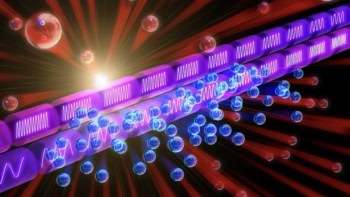The laws of physics cannot distinguish between the past and the future, yet everyday experience tells us that it is impossible to travel backwards in time. Thermodynamics backs this up: entropy or disorder always increases with time. However the CPLEAR collaboration at CERN in Geneva has found that the symmetry between the past and the future is broken in certain particle decays. The results have been accepted for publication in Physics Letters B. An experiment at Fermilab in the US has also found evidence for the violation of time-reversal symmetry.
The CPLEAR collaboration studied the decays of neutral kaons produced in proton- antiproton collisions. The collisions produce both neutral kaons – which contain a down quark and an anti-strange quark – and their antiparticles. These particles can decay in many ways. The CPLEAR team study so-called semileptonic decays in which the neutral kaons decay into a positron, negative pion and a neutrino. They find that this is different to the rate at which the antiparticles decay in an electron, positive pion and an anti- neutrino. If the decay process was time-symmetric the two rates would be the same. This is the first time that the violation of time-reversal (T) symmetry has been observed directly in an experiment.
The KTeV collaboration at Fermilab saw evidence for the violation of T symmetry in very rare decays of neutral kaons into pairs of pions and electrons. Their technique relies on the fact that reversing the direction of time for a particle is equivalent to reversing its momentum. The KTeV team detect the violation of T symmetry by comparing the rates of certain decays with other decays in which the particles emerge in the “time-reversed” direction.
The violation of T symmetry has been expected ever since 1964 when a violation of charge-parity (CP) symmetry in neutral kaons was detected in experiments at the Brookhaven National Laboratory in the US. This discovery led to a Nobel prize for James Cronin and Val Fitch. The violation of both CP and T symmetry is predicted by theory, but their combined effect – so-called CPT symmetry – is thought to be conserved in all quantum field theories.
The December issue of Physics World will contain an article by Nick Mavromatos of Oxford University on the significance of the CPLEAR and KTeV experiments.



